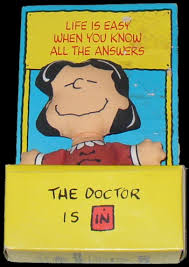The Word Emily
Dickinson Never Used
I can be confounded
It’s an easy excuse
For lack of effort and thought.
I have no idea why
Certain things get dismissed
While others sought.
I can’t identify any difference
Between supposition and truth.
I want my nickel back
From my visit to Lucy’s booth.

"Peanuts" was a syndicated American comic strip written and illustrated by Charles M. Schulz, who personally produced all aspects of the strip himself, from the script to the finished art and lettering. Its 17,897 installments ran from October 2, 1950, to February 13, 2000, the day after its creator's death, perhaps making it the longest story ever told by a single person. (However, Schulz had drawn five additional Sunday strips that appeared on schedule). The first of these strips appeared six days after the last daily on January 9.At its peak it appeared daily in over 2,600 newspapers in 75 countries and had 355 million readers in 21 languages. It developed from "Li'l Folks," a weekly panel comic that appeared in Schulz's hometown paper, the "St. Paul Pioneer Press," from 1947 to 1950. When he went national he transformed the premise from a panel to a four-panel gag strip and had a set cast of characters rather than different, nameless ones for each page (although from 1988, Schulz abandoned the four-panel format in favor of three-panel dailies and occasionally used the entire length of the strip as one panel, partly for experimentation, but mainly due to the dwindling size of the comics page). United Feature Syndicate decided to call it "Peanuts" after the children's audience section called "the peanut gallery" on the popular "Howdy Doody Show" on TV. Schulz always disliked that title, saying, "It's totally ridiculous, has no meaning, is simply confusing, and has no dignity—and I think my humor has dignity." The strip focused entirely on a miniature society of children, with no adult characters ever shown, but had deep philosophical, psychological, and sociological overtones. It depended largely on a series of stock situations that highlighted the personalities and relationships among its cast. One of the main characters (though not introduced until March 1952) was Lucy van Pelt, a bossy, crabby girl who usually tormented the main figure, Charlie Brown. One of the recurring gag situations was Lucy in her homemade stand with a banner sign on top reading "PSYCHIATRIC HELP 5 CENTS" and another below with the message "The doctor is in."
ReplyDeleteWhen my oldest son was two I introduced him to "Peanuts" or Charlie Brown as we called it. Together we watched the holiday specials on a VCR. I noticed it didn't really grab his attention the way other shows and books did. He loved stories so I kept trying until one day he told me he didn't like Charlie Brown because "all they do is argue, Dad". I had to admit I could see why he thought that. To this day (26) he still does not like confrontation or argument. Me, on the other hand, still love Charlie Brown. And now I am all the more informed about it's history . GREAT synopsis. I especially love that Mr. Schultz declared his humor had "dignity". It certainly does.
ReplyDeleteThank you for sharing my poem.
When I was in high school the superintendent would broadcast daily announcements (do they still do that?) and sometimes he would read the newest Peanuts strip or, more likely, something wise from one of them many books.
ReplyDelete